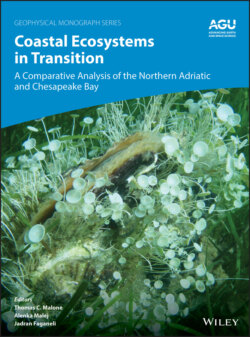Читать книгу Coastal Ecosystems in Transition - Группа авторов - Страница 36
2.5.2. Climate Change
ОглавлениеClimate change is another major challenge to ecosystem restoration (Charlton et al., 2018; Forber et al., 2018; Meier et al., 2018; Rankinen et al., 2016; Sinha et al., 2017). In general, climate change is expected to result in increased air and water temperature and an acceleration of the water cycle (Bloschl et al., 2017; Milly et al., 2005; Najjar et al., 2010; Rice & Jastram, 2014; Rice et al., 2017), which can alter the volume transport of freshwater and inputs of nutrients and sediments. For example, Sinha et al. (2017) estimated that climate‐change‐induced precipitation changes alone will substantially increase (19 ± 14%) riverine inputs of TN within the continental United States by the end of the century. In addition, the effects of climate change can differ among seasons. For CB, projected acceleration of the water cycle is expected to increase river runoff and associated inputs of nutrients and sediments during winter–spring and to decrease runoff during summer–fall (Wagena et al., 2018). Thus, management strategies for CB need to account for the impact of projected climate change on water quality. In this context, modeling and assessment is underway in the Chesapeake Bay Program partnership to evaluate the effects of climate change on nutrient export, efficacy of best management practices, and water quality in the estuary.
In contrast, climate‐driven changes in the water cycle in the NAS watershed may tend toward persistent periods of low runoff alternating with episodic events of high discharge. Climate change appears to be increasing the frequency of heavy precipitation events (Alcamo et al., 2007). This has yet to induce long‐term changes in the annual discharge of the Po River, which has greatly oscillated over the past three decades without showing clear trends (Cozzi & Giani, 2011). However, flow dynamics of Po River are characterized by a shift towards early spring peaks of runoff (Zampieri et al., 2015) and a decline in summer flows (Cozzi et al., 2019). At the same time, the other NAS rivers have shown a strong reduction in flow (Cozzi et al., 2012). It is important to note that reductions in river flow can result from both a greater anthropogenic use of continental waters as well as from climate‐driven changes. For example, annual runoff to Adriatic rivers of Slovenia were reduced (6%) in 1971–2000 due to increased evapotranspiration of the soils (11%), even in the presence of relatively constant precipitation (Frantar, 2007).
